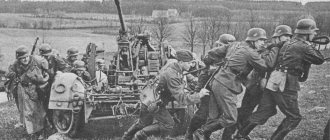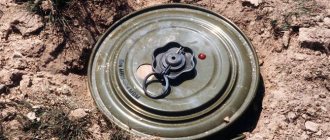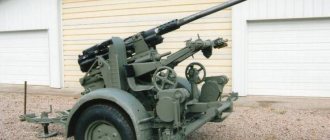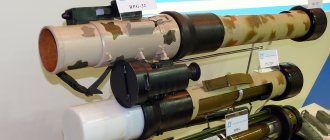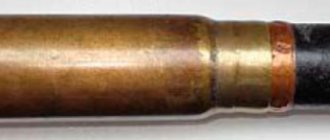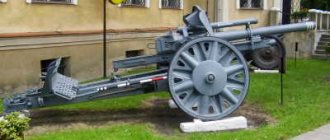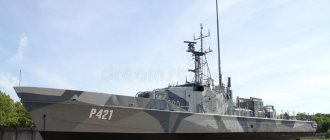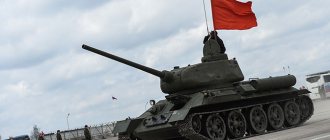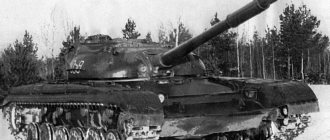Domestic anti-tank self-propelled artillery mounts. Part 1
Before the war in the USSR, numerous attempts were made to create various self-propelled artillery units (self-propelled guns). Dozens of projects were reviewed, and prototypes were built for many of them. But things never came to the point of mass adoption. The exceptions were: 76-mm anti-aircraft gun 29K on the chassis of a YAG-10 truck (60 units), self-propelled gun SU-12 - a 76.2-mm regimental gun of the 1927 model on the chassis of a Morland or GAZ-AAA truck (99 units). ), self-propelled gun SU-5-2 - 122-mm howitzer installation on the T-26 chassis (30 pcs.).
SU-12 (based on the Morland truck)
Of greatest interest in anti-tank terms was the unaccepted SU-6 self-propelled gun on the T-26 tank chassis, armed with a 76-mm 3-K anti-aircraft gun. The installation was tested in 1936. The military was not satisfied that the crew of the SU-6 in the stowed position did not fit entirely on the self-propelled guns and the installers of the remote tubes had to travel in an escort vehicle. This led to the fact that the SU-6 was recognized as unsuitable for escorting motorized convoys as a self-propelled anti-aircraft gun.
SAU SU-6
Although the possibility of using it to fight tanks was not considered, self-propelled guns armed with such guns could become an excellent anti-tank weapon. The BR-361 armor-piercing projectile fired from the 3-K gun, at a distance of 1000 meters, normally penetrated 82 mm armor. Tanks with such armor began to be used en masse by the Germans only in 1943.
To be fair, it should be said that in Germany at the time of the invasion of the USSR there were also no serial anti-tank self-propelled guns (tank destroyers). The first versions of the Artshturm StuG III self-propelled guns were armed with short-barreled 75-mm guns and did not have significant anti-tank capabilities.
German self-propelled gun StuG III Ausf. G
However, the presence of a very successful vehicle in production made it possible to quickly turn it into an anti-tank vehicle by increasing the frontal armor and installing a 75-mm gun with a 43-caliber barrel length.
During the very first battles of the Great Patriotic War, the question arose about the need to quickly develop an anti-tank self-propelled artillery unit capable of quickly changing positions and fighting German tank units, which were significantly superior in mobility to units of the Red Army.
An 57-mm anti-tank gun model 1941, which had excellent armor penetration, was urgently installed on the chassis of the Komsomolets light tractor. At that time, this weapon confidently hit any German tank at real combat distances.
The ZIS-30 tank destroyer was a light, open-type anti-tank gun. The installation's combat crew consisted of five people. The upper mount of the gun was mounted in the middle part of the vehicle body. The vertical aiming angles ranged from -5 to +25°, along the horizon - in the 30° sector. Shooting was carried out only from the spot. The stability of the self-propelled gun when firing was ensured with the help of folding coulters located in the rear part of the vehicle body. For self-defense of the self-propelled gun, a standard 7.62-mm DT machine gun was used, mounted in a ball joint on the right in the front plate of the cab. To protect the crew from bullets and shrapnel, an armored shield cover for the gun was used, which had a hinged upper part. In the left half of the observation shield there was a special window, closed with a movable shield.
PT self-propelled gun ZIS-30
Production of the ZIS-30 lasted from September 21 to October 15, 1941. During this period, the plant produced 101 vehicles with the ZIS-2 cannon (including an experimental vehicle) and one installation with a 45-mm cannon. Further production of the mounts was stopped due to the lack of discontinued Komsomolets and the cessation of production of 57 mm guns.
Self-propelled guns ZIS-30 began to enter service at the end of September 1941. They equipped the anti-tank batteries of 20 tank brigades of the Western and Southwestern Fronts.
During intensive use, the self-propelled gun revealed a number of shortcomings, such as poor stability, overloaded chassis, small power reserve, and small ammunition load.
By the summer of 1942, there were practically no ZIS-30 tank destroyers left in the troops. Some of the vehicles were lost in battles, and some failed due to technical reasons.
In January 1943, serial production of the products created by N.A. began. Astrov on the basis of the T-70 light tank, SU-76 self-propelled 76-mm units (later Su-76M). Although this light self-propelled gun was very often used to fight enemy tanks, it cannot be considered anti-tank. The armor protection of the SU-76 (front: 26-35 mm, side and rear: 10-16 mm) protected the crew (4 people) from small fire and heavy fragments.
Self-propelled gun SU-76M
When used correctly, and this did not happen right away (self-propelled guns are not a tank), the SU-76M performed well both in defense - when repelling infantry attacks and as mobile, well-protected anti-tank reserves, and in the offensive - when suppressing machine gun nests, destroying pillboxes and bunkers, as well as in the fight against counterattacking tanks. The ZIS-3 divisional gun was installed on the armored vehicle. Its sub-caliber projectile from a distance of 500 meters penetrated armor up to 91 mm, that is, any place on the hull of German medium tanks and the side of the “Panther” and “Tiger”.
In terms of weapon characteristics, the SU-76I self-propelled guns, created on the basis of captured German tanks Pz Kpfw III and StuG III self-propelled guns, were very close to the SU-76M. Initially, it was planned to install a 76.2-mm ZIS-3Sh (Sh - assault) cannon in the fighting compartment of the self-propelled gun; it was this modification of the gun that was installed on the serial self-propelled guns SU-76 and SU-76M on a machine fixed to the floor, but such an installation did not provide reliable protecting the gun embrasure from bullets and shrapnel, since when lifting and turning the gun, cracks invariably formed in the shield. This problem was solved by installing a special self-propelled 76.2 mm S-1 gun instead of the 76-mm divisional gun. This gun was designed based on the design of the F-34 tank gun, which was equipped with T-34 tanks.
Self-propelled gun SU-76I
With the same firepower as the SU-76M, the SU-76I was much more suitable for use as an anti-tank due to its better protection. The front of the hull had anti-ballistic armor with a thickness of 50 mm.
Production of the SU-76I was finally stopped at the end of November 1943 in favor of the SU-76M, which had already gotten rid of “childhood diseases” by that time. The decision to stop production of the SU-76I was due to a reduction in the number of Pz Kpfw III tanks used on the Eastern Front. In this regard, the number of captured tanks of this type decreased. A total of 201 SU-76I self-propelled guns were produced (including 1 experimental and 20 command ones), which took part in the battles of 1943-44, but due to small numbers and difficulties with spare parts, they quickly disappeared from the Red Army.
The first specialized, domestic tank destroyer capable of operating in battle formations on a par with tanks was the SU-85. This vehicle became especially in demand after the appearance of the German PzKpfw VI “Tiger” tank on the battlefield. The Tiger's armor was so thick that it could only be penetrated with great difficulty and only at suicidal close distances by the F-34 and ZIS-5 guns mounted on the T-34 and KV-1.
Special firing at a captured German tank showed that the M-30 howitzer mounted on the SU-122 has an insufficient rate of fire and low flatness. In general, it turned out to be poorly suited for shooting at fast-moving targets, although it had good armor penetration after the introduction of cumulative ammunition.
By order of the State Defense Committee dated May 5, 1943, the design bureau under the leadership of F.F. Petrov began work on installing an 85-mm anti-aircraft gun on the SU-122 chassis.
Tank destroyer SU-85 with D-5S gun
The D-5S gun had a barrel length of 48.8 calibers, the direct fire range reached 3.8 km, the maximum possible was 13.6 km. The range of elevation angles was from −5° to +25°, the horizontal firing sector was limited to ±10° from the longitudinal axis of the vehicle. The gun's ammunition capacity was 48 rounds of unitary loading.
According to Soviet data, the 85-mm armor-piercing projectile BR-365 normally penetrated an armor plate 111 mm thick at a distance of 500 m, and at twice that distance under the same conditions - 102 mm. The BR-365P sub-caliber projectile at a distance of 500 m normally pierced an armor plate 140 mm thick.
The control, engine and transmission compartments remained the same as those of the T-34 tank, which made it possible to staff the crews for the new vehicles with virtually no retraining. For the commander, an armored cap with prismatic and periscope instruments was welded into the roof of the cabin. On self-propelled guns of later production, the armored cap was replaced by a commander's cupola, like the T-34 tank. The general layout of the vehicle was similar to that of the SU-122, the only difference being in the armament. The security of the SU-85 was similar to that of the T-34.
Vehicles of this brand were produced at Uralmash from August 1943 to July 1944; a total of 2,337 self-propelled guns were built. After the development of the more powerful SU-100 self-propelled gun, due to the delay in the release of 100-mm armor-piercing shells and the cessation of production of armored hulls for the SU-85, a transitional version of the SU-85M was produced from September to December 1944. In fact, it was an SU-100 with an 85-mm D-5S cannon. The modernized SU-85M differed from the original SU-85 in having more powerful frontal armor and increased ammunition capacity. A total of 315 of these machines were built.
Thanks to the use of the SU-122 hull, it was possible to very quickly establish mass production of the SU-85 tank destroyer. Operating in battle formations of tanks, they effectively supported our troops with fire, hitting German armored vehicles from a distance of 800-1000 m. The crews of these self-propelled guns were especially distinguished during the crossing of the Dnieper, in the Kiev operation and during the autumn-winter battles on the Right Bank of Ukraine. Apart from the few KV-85 and IS-1, before the advent of the T-34-85 tanks, only the SU-85 could effectively fight enemy medium tanks at distances of more than a kilometer. And at shorter distances it can penetrate the frontal armor of heavy tanks. At the same time, already the first months of use of the SU-85 showed that the power of its gun is insufficient to effectively combat enemy heavy tanks, such as the Panther and Tiger, which, having an advantage in firepower and protection, as well as effective aiming systems, imposed combat from long distances.
Built in mid-1943, the SU-152 and the ISU-122 and ISU-152 that appeared later could destroy any German tank if hit. But due to their high cost, bulkiness and low rate of fire, they were not very suitable for fighting tanks. The main purpose of these vehicles was the destruction of fortifications and engineering structures and the function of fire support for advancing units.
In mid-1944, under the leadership of F. F. Petrov, using shots from the B-34 naval anti-aircraft gun, an even more powerful 100-mm D-10S gun was designed. Gun D-10S arr. 1944 (index “C” - self-propelled version), had a barrel length of 56 calibers. The cannon's armor-piercing shell hit armor 124 mm thick from a distance of 2000 meters. A high-explosive fragmentation projectile weighing 16 kg made it possible to effectively hit manpower and destroy enemy fortifications.
Using this gun and the base of the T-34-85 tank, Uralmash designers quickly developed the SU-100 tank destroyer - the best anti-tank self-propelled gun of the Second World War. Compared to the T-34, the frontal armor was strengthened to 75 mm. The gun was installed in the front slab of the wheelhouse in a cast frame on double axles, which allowed it to be aimed in the vertical plane within the range from −3 to +20° and in the horizontal plane ±8°. The aiming was carried out using a manual sector-type lifting mechanism and a screw-type rotating mechanism. The gun's ammunition consisted of 33 unitary rounds, placed in five stacks in the wheelhouse.
The SU-100 had exceptional firepower for its time and was capable of fighting enemy tanks of all types at all aimed fire distances. Serial production of the SU-100 began at Uralmash in September 1944. By May 1945, the plant managed to produce more than 2,000 of these machines. The SU-100 was produced at Uralmash at least until March 1946. Omsk Plant No. 174 produced 198 SU-100s in 1947, and 6 more at the beginning of 1948, producing a total of 204 vehicles. Production of the SU-100 in the post-war period was also established in Czechoslovakia, where in 1951-1956 another 1,420 self-propelled guns of this type were produced under license.
In the post-war years, a significant part of the SU-100 was modernized. They were equipped with night surveillance devices and sights, as well as new fire-fighting and radio equipment. A shot with a more effective armor-piercing UBR-41D projectile with protective and ballistic tips was introduced into the ammunition load, and later with sub-caliber and non-rotating cumulative projectiles. The standard ammunition of self-propelled guns in the 1960s consisted of 16 high-explosive fragmentation, 10 armor-piercing and 7 cumulative shells.
Sharing the same base with the T-34 tank, the SU-100 has spread widely around the world, officially being in service in more than 20 countries, and has been actively used in numerous conflicts. In a number of countries they are still in service. In Russia, the SU-100 could be found “in storage” until the end of the 90s.
Based on materials: https://dic.academic.ru/dic.nsf/enc_tech/4200/SU https://www.tankovedia.ru/catalog/sssr/su https://voencomrus.ru/index.php?id =120
Development of wheeled self-propelled guns in Russia
In the modern Russian armed forces, intensive work is underway to create various artillery systems on a wheeled chassis. How did wheeled artillery mounts evolve in the past? Why did the Russian army need such self-propelled guns? Read our material.
Even during the early construction of the Red Army, the Soviet Union took the creation of advanced weapons very seriously; the events of the First World War, the Civil War and a number of local conflicts further spurred the USSR to build a powerful army. This also applied to artillery.
At the same time, the twenties and thirties of the twentieth century became a real boom in the development of various types of artillery systems, entire families of completely new guns were created: rapid-fire guns, anti-aircraft guns, anti-tank guns, universal artillery and others. At the same time, the concept of moving the gun on the battlefield also underwent changes. Many military experts rightly believed that artillery in battle should continuously accompany and support troops and therefore its own mobile base should be created for it.
Similar ideas circulated among the military leadership of the USSR. However, if in a number of countries the main driver for such systems were tracked platforms, then in the Soviet Union this matter was not so smooth. There was a catastrophic lack of tracked vehicles, especially since one of the main directions of military development was the creation of powerful armored forces, while there were clearly not enough resources for the production of self-propelled artillery units.
Under these conditions, the military leadership of the USSR decided to create a mobile artillery system on the chassis of the American Morland wheeled truck. It was decided to place the then modern 76-mm regimental gun of the 1927 model in the body of the vehicle as the main armament. In 1933, this artillery system was tested, which were generally considered very successful. In the same year, serial production of a self-propelled gun called SU-12 began.
Subsequently, the production of this wheeled self-propelled artillery mount (SAU) was established on the GAZ-AAA chassis. Because of this, combat vehicles produced on the GAZ-AAA basis began to be called SU-1-12. A total of 48 self-propelled guns were produced based on Morland and 51 based on GAZ-AAA.
SU-12 actively took part in exercises and maneuvers of the Red Army, and subsequently they were used in combat. In 1938, 8 SU-1-12 took part in combat operations against the Japanese army on Lake Khasan. The wheeled self-propelled guns supported the BT-5 and T-26 tanks going on the attack with their fire. In total, about 248 shells were fired at the Japanese troops; the self-propelled guns did not suffer any losses in the battles, and their combat use was considered generally successful. In very limited quantities, these self-propelled guns took part in the fighting near the Khalkhin Gol River and the winter war with Finland.
Despite the generally successful combat use of the SU-12, the military was mostly skeptical about these vehicles. Even at the time of their creation, these self-propelled guns were considered rather a temporary solution and subsequently had to be replaced by tracked counterparts. The weak protection of both the installations themselves and the calculations was also seriously criticized. The vehicle's insufficient maneuverability, the impossibility of further modernization, and the installation of more powerful guns also caused criticism.
All this led to the fact that in 1935 the production of these self-propelled guns stopped. The SU-12 also failed to take part in the Great Patriotic War; almost all vehicles of this type had completely exhausted their service life by that time. By the beginning of the war, three wheeled self-propelled guns remained in the Red Army units in the Trans-Baikal Military District, but were also subsequently decommissioned from combat service.
After the combat debut of various self-propelled guns on tracked chassis during the Great Patriotic War, the idea of developing wheeled barrel artillery remained buried for a long time. They returned to this concept in the USSR only in the 80s.
The combat operations in Afghanistan demonstrated that tracked self-propelled guns are not always easy to use. They significantly limited the speed of military units and were not suitable for covering army columns. This problem had to be solved using available resources. Thus, various guns and mortars began to be mounted on the backs of trucks, thereby turning ordinary vehicles into high-speed artillery installations.
The experience of using these homemade self-propelled guns was not ignored by the country's military leadership, and design bureaus began developing modern self-propelled artillery mounts on a wheeled chassis.
Thus, it was planned to create a whole family of wheeled self-propelled guns for the battalion, regimental and divisional level. One of the ambitious projects was an attempt to transfer the Msta howitzer to the chassis of a KrAZ vehicle. The project was named "Msta-K", where the letter "K" denoted the wheelbase. Work on the project, which began in 1985, made it possible by 1987 to create technical documentation and put up a prototype self-propelled gun for testing.
During the tests, the military commission identified a number of shortcomings in the truck's wheelbase and in its conclusion demanded their elimination. However, the Ministry of the Automotive Industry considered the voiced requirements difficult to eliminate and expensive, so the Msta-K project was quickly closed.
A similar fate befell many wheeled self-propelled gun projects of that time. However, some ideas still managed to come to life. Thus, since the late 70s, the USSR has been developing a self-propelled artillery mount to support the defense of the coastline. In 1988, tests began on a prototype self-propelled gun on the MAZ-543M chassis, called the A-222 “Bereg”.
The tests were considered successful and in the same 1988, serial production of this self-propelled gun began. "Bereg" had very good characteristics for its time. It made it possible to strike small and medium-sized surface ships moving at speeds of up to 100 knots (more than 180 km per hour) from a distance of up to 20 kilometers. A high degree of system automation has been achieved at Bereg. This complex is capable of hitting ground targets.
However, “Bereg” was created primarily to protect the coastline, and not as a full-fledged self-propelled gun to support ground forces. Work on finding the optimal wheeled self-propelled gun for army units continued.
In 1983, using the developments gained during work on the Zhalo-S anti-tank self-propelled gun based on the BTR-70, a prototype self-propelled gun was manufactured on the same base, but with a combat module from the Nona-S airborne self-propelled gun. Tests of this vehicle showed positive results, and work on a wheeled self-propelled gun based on an armored personnel carrier continued.
In 1984, work began on a wheeled self-propelled gun based on the BTR-80, and in the same year a prototype was created, which first underwent factory and then field tests. After identifying and eliminating the shortcomings, the new wheeled self-propelled gun was adopted by the USSR Armed Forces in 1991 under the designation 2S23 “Nona-SVK”.
“Nona-SVK” was a BTR-80 wheelbase with a combat module from the Nona-S self-propelled gun installed on it instead of a machine gun turret, with the ability to mount a PKT machine gun on the roof of the turret. It is noteworthy that military officials were so confident in the success of this vehicle that serial production of the self-propelled guns was organized in 1990, that is, a year before the official adoption. This largely helped to produce about 30 vehicles before 1991 and equip troops with a minimum number of 2S23s before the collapse of the Soviet Union.
After the collapse of the USSR, the bulk of these self-propelled guns went to the Russian Federation. And already in the 90s they were used in combat during the First Chechen War. Nona-SVK, as intended, was used in general to support troops, suppress enemy fire positions in buildings and fire from indirect positions like other howitzer systems. At least one Nona-SVK was lost during the fighting.
To some extent, Nona-SVK was also a commercial success. Thus, more than a dozen of these self-propelled guns were supplied to the ground forces of Venezuela. However, in the domestic armed forces the number of wheeled self-propelled guns of this type remained very limited. Initially, this was due to the difficult economic situation of the country after the collapse of the USSR.
After Serdyukov came to the post of Russian Defense Minister, Nona-SVK also did not find its place in the lists of purchased weapons for the needs of the Russian army. According to the Minister of War, this was due to the obsolescence of this self-propelled gun and its failure to fit into the general image of the Russian armed forces.
At the same time, the designers tried to create a new self-propelled gun based on the promising BTR-90 armored personnel carrier by installing a combat module from the 2S31 “Vena” self-propelled gun into it, but after, on the orders of Serdyukov, the Ministry of Defense refused to purchase the BTR-90 and all work on this self-propelled gun were rolled up. Purchases of Nona-SVK for the needs of the Russian army were continued only in 2022, when the Ministry of Defense was already firmly headed by Sergei Shoigu.
The war in Chechnya again demonstrated the need for self-propelled artillery on wheeled vehicles, but due to the difficult economic situation, the industry clearly could not quickly produce the weapons the army needed. As during the war in Afghanistan, it was necessary to create “self-propelled guns on wheels” using army trucks.
Subsequently, domestic designers tried to solve this problem by remaking the GAZ-3937 Vodnik armored car by demonstrating the rear upper part of the hull and installing a platform for mounting mortars directly in the body of the vehicle. However, the Vodnik armored vehicles themselves did not gain popularity among the Russian troops due to the obsolescence of their concept and a number of technological imperfections, and such a self-propelled gun was clearly not what the military wanted to see. Therefore, the mortar version of the Vodnik armored vehicle remained a prototype.
At the same time, in the 2000s, a real boom in wheeled self-propelled guns began. Many countries began to create similar equipment, equip their troops with them and export them. In Russia, this concept remained unclaimed for a long time. However, everything changed after Russian troops entered the war in Syria.
During the conflict, the creation of various homemade wheeled self-propelled guns was put on stream by many warring parties. These wheeled self-propelled guns actively and very successfully participated in battles. They made it possible to accompany troops on the offensive, had good mobility and could quickly evade possible retaliatory fire from the enemy. The Russian military has become seriously interested in the concept of such self-propelled guns. Subsequently, this resulted in the creation of many wheeled artillery self-propelled guns in Russia.
Already in 2016, at a closed display of the Army-2016 military forum, a new self-propelled unit based on the Tiger armored car with a 120-mm Sani mortar, called the MZ-304 Highlander, was presented.
In addition to its powerful 120-mm mortar, this self-propelled gun also stands out for its serious automation of both the firing processes and the reloading of the main gun. When firing an SPG, the crew does not need to leave the vehicle; loading is carried out in semi-automatic mode, when the loader, through a special reloading window, sends a mine into the barrel of a horizontally inclined mortar. After this, the mortar automatically takes up the firing position.
The mortar is capable of firing any type of 120 mm mortar. Information about targets flows to the computer of the crew commander. Another advantage of this self-propelled gun is that, if necessary, the mortar barrel can be removed and, using the plate and carriage located in the vehicle, assembled into a regular portable mortar. This is a particularly useful feature if the car loses the ability to move or is unable to drive anywhere. At the moment, this self-propelled gun is undergoing state tests.
Another wheeled self-propelled gun that can be adopted by the Russian army is the 2S36 “Zuralets-D”, which is being created for the needs of the Airborne Forces. This self-propelled gun is designed on the basis of the VPK-39373 Volk-3 armored vehicle using the 2B16 Nona-K as the main weapon. In addition, work is underway on a self-propelled version and on the BMD-4M tracked base.
According to the developers, Zauralets-D is capable of landing from transport aircraft and firing both mortar shells and artillery shells from its 120-mm cannon. It is worth noting that testing of this self-propelled gun is still ongoing, and the military will have to choose either a tracked or wheeled self-propelled gun, but some experts are inclined to believe that both options will be put into service.
Wheeled self-propelled guns such as “Phlox” for the needs of the ground forces and “Drok” for airborne units are also being tested. According to the developers, the tests should be completed in a year and a half.
Perhaps, to date, the crowning achievement of the development of wheeled self-propelled guns in Russia has been the creation of a wheeled version of the Koalitsiya-SV self-propelled gun.
According to the Ministry of Defense, this self-propelled gun is created primarily by processing Syrian experience. The wheeled "Coalition-SV" must retain the basic parameters of its tracked version, but must be cheaper to produce and be able to be transported by transport aircraft. The deployment time of the self-propelled guns is about one and a half minutes. The rate of fire should be about 16 rounds per minute. This complex is currently undergoing state tests.
It is worth noting that now the Russian defense industry is actually creating a lot of self-propelled guns on wheels, which is why the military has a wide choice in purchasing weapons necessary for certain tasks. At the same time, the developers themselves hope to gain export potential from their products.
During the battles in Syria, wheeled self-propelled guns showed themselves to be a promising type of equipment, at the same time, the main reasons in the form of weak armor and poor mobility, which slowed down such a concept, have now been resolved by creating more powerful vehicles and using the MCI concept in them. At the moment, wheeled self-propelled guns have a number of advantages over their tracked counterparts. First of all, this is due to mobility, since modern wars for the most part come down to maneuverable combat operations, where the fact of combining the speed of troops and their firepower is important. The adoption of wheeled self-propelled guns will help to seriously strengthen the power of the Russian army, level out its lag in this class of weapons and will allow for quick operations, which often become decisive in modern conflicts.
Alexander Dolbysh for ANNA-News.
If you find an error, please select a piece of text and press Ctrl+Enter.
Dolgorukaya gun: the firing range of Russian artillery will increase five times
Russian artillery will learn to hit targets at a distance of over 100 km. Ultra-long-range guided projectiles will soon be added to the ammunition loads of the Coalition and Msta installations. Until now, the maximum flight distance of adjustable ammunition did not exceed 20 km. The increased range will allow conventional self-propelled guns to hit critical targets - control posts, headquarters, airfields, communications centers and bridges deep behind enemy lines. The new product will radically increase the capabilities of the ground forces, experts say.
The rocket turns
As sources in the military-industrial complex told Izvestia, work is now underway on several versions of ultra-long-range projectiles for the newest 2S35 Koalitsiya-SV howitzer. The publication’s interlocutors refused to name the exact timing of their completion, but explained that the developments will be transferred for testing in the near future. Unique ammunition will allow the Coalition to carry out precision strikes at a distance of over 100 km. The new items will also replenish the ammunition load of howitzers of the Msta family.
Tests of the Koalitsiya-SV self-propelled gun were shown on video
One of the projects for ultra-long-range ammunition is a telescopic guided projectile with a ramjet engine. Currently, research work is already underway to create an exotic ammunition that unfolds in flight, like a spyglass. This transformation makes it possible to improve the performance of the built-in engine and radically increase the range compared to the traditional design.
Currently, the most popular Russian guided artillery projectile, the Krasnopol, has a maximum range of 20 km. The “Coalition” with new high-precision ammunition will be able to hit targets with single shots even deep behind enemy lines. With them, it will solve combat missions that were previously handled by operational-tactical missiles.
“The target can be highlighted from a drone,” military expert Viktor Murakhovsky told Izvestia. “But there are other technical solutions that allow us to achieve high accuracy. In this area, we will be on a par with the most advanced developments in Western countries.
The main purpose of adjustable ammunition is to hit particularly important targets in tactical depth: command posts, communication centers, missile launch positions, airfields, helicopter landing sites, the expert added.
“Currently there are no long-range weapons at the division-corps level,” noted Viktor Murakhovsky. — In Soviet times, each division had a division with Tochka missile systems, but now such means are not provided for in the regular structure of formations. As a result, the commander does not have at hand fire weapons capable of hitting targets to the full depth in his area of responsibility. The general has to turn to a senior commander for help, and there is no guarantee that it can always be provided.
“Lotus” on Red Square: a mortar gun will be shown at the Victory Parade
A new artillery system has been created for the Airborne Forces
Unlike ballistic missiles, an artillery shell cannot be intercepted by air defense systems. Its flight time is shorter. The ammunition arrives completely suddenly, not giving the enemy time to take cover or move.
The Pentagon is also developing ultra-long-range projectiles. To increase the capabilities of conventional field artillery, the United States plans to create a new cannon under the designation ERCA (Extended-range cannon) and ammunition for it. With the active-reactive XM113, the upgraded M109A7 self-propelled howitzers should have a range of 40 km. And with an extended barrel and a promising projectile equipped with a ramjet engine, the distance will increase to more than 100 km.
Anti-terror shells
Promising principles for the use of artillery and precision projectiles were tested by the Russian Armed Forces in Syria. In November 2022, video footage appeared of the destruction of dozens of terrorist targets using guided munitions. They were aimed at the target using drones. The drone detected targets and promptly transmitted data to Krasnopoli. In this way, it was possible to destroy even small dugouts and pickup trucks of militants.
In January 2022, according to the Ministry of Defense, a group of militants in Idlib was eliminated by guided missiles. It attacked the Russian Khmeimim airbase with drone bombers.
In February of this year, new footage of the massive use of guided artillery munitions in Syria appeared in the media.
Adjustable 152mm shells cause less collateral damage than heavy aerial bombs, which is especially important when fighting in densely populated areas. With a high-precision hit, when the deviation is less than a meter, ammunition of this caliber is sufficient to destroy most objects on the battlefield.
Howitzer with delivery: a mobile version of the Coalition complex has been developed
The army will receive a new lightweight but powerful artillery mount
According to the developers, new models of heavy and medium Russian drones can be equipped with powerful laser rangefinders and target designators. This will make it possible to use them as gunners for existing and new long-range guided projectiles even at the maximum firing distances of howitzers.
The many faces of the “Coalition”
The promising Russian self-propelled gun mount was officially presented in 2015. It was demonstrated on Red Square on May 9. And its development began much earlier, in 2006. The first two prototypes were ready in 2013, and then their testing began. The following year, an experimental batch of 10 prototypes was produced on the T-90 tank chassis, which took part in the Victory Parade.
In February 2022, it became known that the first batch of four pre-production samples on the new chassis was ready for delivery to the army. It is expected that their military trials will last until 2022. After the start of serial production, the howitzers will go into service with individual artillery brigades. Perhaps these installations will also be adopted by the coastal artillery of the fleet.
Testing of the wheeled version of the Coalition on the chassis of a KamAZ truck with an 8*8 wheel arrangement is also underway. He will be able to make long marches on ordinary roads without destroying their surface. The mobility of wheeled self-propelled guns in a developed road network is higher than that of traditional tracked ones. According to Dmitry Semizorov, head of Uraltransmash, where the Coalitions are produced, the Ministry of Defense is also interested in such an artillery mount.
Morally obsolete Russian towed howitzers will get a new life - experts “plan to equip them with modern automated and electronic equipment. Is such a step really necessary and how advisable is it to modernize the weapons of the past, PolitRussia .
"Smart" artillery
rostec.ru / Press service of Rostec
The All-Russian Research Institute "Signal" (part of the Rostec state corporation) will develop a set of unified equipment that will provide automatic data input for firing and guidance on towed guns. Thus, classic howitzers, which the military itself often calls “convertibles,” will be able to reach the level of highly effective artillery systems. Specialists from the All-Russian Scientific Research Institute "Signal" have already carried out a number of scientific studies, within the framework of which the possibility of automating cannon towed artillery to dramatically increase its efficiency was explored. And the fundamental possibility of such modernization has been officially confirmed. As reported, designers will begin developing a new system in the very near future.
As is known, in the arsenal of the Russian army, along with self-propelled artillery units, today there is a whole range of towed guns, the input of data for firing, targeting and fire in which are carried out manually by combat crews. However, the requirements of modern combat operations require an increasingly high degree of automation of weapons within the framework of a single reconnaissance and strike system. In particular, for artillery it is planned to automatically receive information about enemy targets and coordinates via communication channels, automatically target and calculate the moment to open fire. Due to manual control, non-self-propelled howitzers are deprived of the ability to fully integrate into a single information field in real time.
Prt Scr youtube.com / ROY TV
As Konstantin Sivkov , corresponding member of the Russian Academy of Missile and Artillery Sciences, military expert PolitRussia , any artillery system, especially a towed one (that is, without restrictions on the chassis), can be modernized to reduce reaction time, increase accuracy of fire, the ability to quickly collapse and deploy. At the same time, modernization itself can be carried out in several directions at once.
“The first is to increase shooting accuracy by pairing with modern target issuance and indication systems, in particular with artillery reconnaissance stations. The second is a reduction in reaction time, that is, the time from the moment the task is set to the release of fire. Thirdly, there may be a modernization of the charging system, which will increase the rate of fire and reduce the time it takes to complete tasks,” explains the expert.
As for the modernization of the artillery solution, that is, changes in the ballistic characteristics of the gun, such tasks are also set for the designers. There may be several options here: the use of a new barrel, an increase in the volume of the powder charge, and the use of new forms of projectile - due to all these factors the combat power of almost any howitzer can be improved.
Military expert and director of the Museum of Russian Air Defense Forces, retired colonel Yuri Knutov . In an interview with our publication, he emphasized that such automation will shorten the combat control cycle several times, and will also ensure its integration into an automated troop control system.
“The inclusion of such tools in an automated control system is happening today all over the world. It is possible, of course, to create new self-propelled howitzers, and we are doing this too. And, if we talk about self-propelled guns, then here we are completely ahead of the rest. But there were some problems with conventional towed guns. The main thing is the issue of speed. From the moment of receiving information about the target to entering the coordinates, a lot of time passes, during which the target can move, which is why the accuracy of the hit decreases. When everything is done online, it meets the requirements of today,” notes Knutov.
According to him, one cannot help but note the very fact of replacing the usual combat crew, consisting of several people, with automation. In this context, automation will eliminate the human factor and eliminate errors when aiming a gun and directly shooting. They cannot be underestimated, because an erroneously aimed weapon can hit friendly troops.
American example
wikipedia.org/Allied Joint Force Command Brunssum; Vitaly V. Kuzmin
Speaking about the practice of re-equipping towed howitzers, one cannot fail to note the experience of other countries in this direction. As Yuri Knutov notes, the greatest success here has been achieved by the country that invariably ranks first in various rankings of the best armies in the world - the United States of America. The United States, much like Russia, has a rich history of using towed artillery, which also constantly goes through various stages of modernization.
“Not only we, but also many other countries around the world are developing such systems. First of all, this is, of course, the USA. Their technologies easily allow you to enter data from the same drones and instantly transfer it to the weapon. And this moment - a second - is essentially the most precious. To avoid even such losses, a gun guidance system is being introduced. A small electric motor is installed, which, based on the received data, instantly works out the aiming and, under the control of the combat crew, fires,” explains the expert.
In particular, in the USA and some other NATO countries, the 155-mm M777 howitzer manufactured by BAE Systems is used for similar purposes. The gun entered service with the Army and Marine Corps in 2005, and the US military now has more than 900 units at its disposal. The very first modification of this gun had an optical fire control system, later a power source, GPS system, inertial navigation, radio receiver, display, automatic loader and a new fire control system were added to it. Currently, the M777 is actively used by the US military in Syria, Iraq and Afghanistan.
wikipedia.org/Allied Joint Force Command Brunssum; Vitaly V. Kuzmin
Also, the US Armed Forces and their allies use 105-mm M119 howitzers, capable of effectively destroying lightly armored enemy vehicles and fortified objects at a distance of up to 19 kilometers. The gun entered service with the troops back in 1989 and managed to serve the American military in many hot spots. Subsequently, the weapon was modernized: in 1998, new sighting devices were installed on it, and in 2013, a digital fire control system and an inertial navigation system were installed.
Despite the fact that in 2022 the US Department of Defense announced plans to create a new towed howitzer, the Pentagon still does not intend to abandon either the M777 or the M119. According to Yuri Knutov, this is an absolutely justified and logical decision - both guns have good ballistic data, which remains quite competitive to this day. The expert is confident that Russia should follow the same path - at a minimum, such modernization will have a positive effect in terms of saving money and increasing accuracy, and at maximum, it will equip the Russian army with fundamentally new artillery pieces.
Soviet legacy
wikipedia.org/ShinePhantom
Of the domestic towed artillery, the RF Armed Forces have 200 units (150 units in service with the ground forces, 50 guns in service with the coastal forces of the Russian Navy) of the 152-mm howitzer 2A65 "Msta-B" - a towed version of the self-propelled artillery mount 2S19 "Msta-S" , developed back in 1976. In addition, over 600 more units of this weapon are stored in Russian warehouses. We also cannot help but recall another “relic” remaining from the Soviet period – the 100-mm towed anti-tank gun MT-12 “Rapier”, first produced in 1970.
As Konstantin Sivkov notes, both guns, despite their advanced age, still remain extremely effective weapons even in comparison with their younger Western counterparts. For example, Msta-B significantly outperforms the American M777 and M119 in range - 29.8 kilometers versus 24 and 19 kilometers, respectively. The Rapier's performance, however, looks much more modest - it is capable of firing at a distance of 3 to 8 kilometers, depending on the type of projectile chosen. However, in her case this is not critical - the gun is designed exclusively for shooting at tanks. Moreover, Konstantin Sivkov emphasizes, if we consider the 2A65, then it can compete with modern foreign self-propelled artillery units.
“If we talk about the same Msta-M howitzer, then it fully meets modern requirements. It surpasses the American M109 self-propelled gun in terms of firing range and rate of fire performance, and is only slightly inferior in terms of firing range to the German Panzerhaubitze 2000. But, for example, our new Coalition gun is completely superior to all foreign models - its firing range reaches 70 kilometers , and there is nothing like this anywhere else,” explains Konstantin Sivkov.
wikipedia.org/Bukvoed/CC BY 2.5
According to him, the “Coalition” in this case should be understood not as the 2S35 self-propelled artillery system, but as its towed version – the D-400 howitzer gun, which has been under development since 2022. It will initially be equipped with the latest automated equipment and will represent a new word in domestic towed artillery. However, Yuri Knutov believes that today even the rare Soviet howitzers have not yet had their say. And with new electronics, they will no doubt have this opportunity.
“We, in principle, have a large number of really powerful towed artillery pieces. You can even look at the period of World War II - for example, at the 152-mm howitzer D-1, which appeared back in 1943. There is the legendary 122-mm howitzer D-30, which to this day remains one of the most popular artillery systems in the world. Not only is it in service, it is still produced in some countries. In Peru, for example, it was installed on a light tank. That is, there can be no problems with modernization in this case,” says the military expert.
According to him, if modern active-missile projectiles are used, the D-30 howitzer is capable of hitting targets at a distance of up to 22 kilometers, which makes it an absolutely competitive weapon in terms of ballistic characteristics. Thus, the resurrection of archaic, at first glance, cannons and howitzers will turn out to be a truly profitable solution.
A question of expediency
wikipedia.org/Allied Joint Force Command Brunssum; Vitaly V. Kuzmin
However, we should not forget that any modernization requires a significant investment, as a result of which the question involuntarily arises: will the final result be worth all the effort? According to experts, we can debate the answer to this question for a long time, but it would be wiser to resort to banal figures. Today, the Russian army has about 700 D-1 installations, more than 4 thousand D-30 howitzers, over 2 thousand Rapier guns and, as mentioned earlier, approximately 600 Msta-B howitzers in storage. And all this does not take into account those installations that are currently still on combat duty.
Of course, experts note, not all of them will be modernized, but the total number of such systems speaks to the main thing - Russia, without spending money on global new developments and solutions, is able to increase its artillery capabilities several times by creating a set of unified equipment. The extent to which such a process can modernize seemingly outdated weapons is clearly demonstrated by the example of the Malka self-propelled gun, a modernized version of the 2S7 Pion gun, created in the 1980s.
“Malka” is the most powerful self-propelled gun in the world, when compared with all models currently in the armed forces of different countries. One of its shells weighs about 100 kilograms - no one else has this. And, if “Pion” was, as they say, bare metal, then “Malka” received a new tracked platform and navigation, communications and fire control systems. The combat module itself is essentially not afraid of time. The same thing will happen with our howitzers,” explains Yuri Knutov.
According to him, if you follow the example of the same “Malka”, then after modernization it was able to integrate into an automated system for controlling troops and weapons. The same future holds for towed howitzers. Already now, reconnaissance and strike systems are being created in the Russian Federation, which involve the integration of all combat and information and reconnaissance assets into a network, which should ensure superiority over the enemy by increasing the speed, accuracy and efficiency of hitting targets. And, the expert notes, howitzers of the last century have all the necessary drives for integration into such a system.
wikipedia.org/mil.ru/CC BY 4.0
Much more difficult is to find an answer to the question of the role of the towed artillery itself in the current conditions. Some experts seriously view non-self-propelled howitzers as a kind of anachronism that does not play a serious role in modern warfare. Moreover, their extremely low mobility makes them an easy target for enemy attacks. According to Yuri Knutov, this remark is indeed true, but only partly true.
“Of course, there are disadvantages in any situation. The most important thing is that the combat crew is poorly protected from bullets and fragments of enemy shells. If self-propelled guns use anti-fragmentation armor, and they themselves have better speed and maneuverability, then towed guns do not have all this. But where the use of artillery on the battlefield is not required, and there is no threat to life, such howitzers will be very effective. They shot back and left, as they say,” the expert is sure.
Konstantin Sivkov, in turn, notes that despite the obvious disadvantages - a long time for deployment, reaction and leaving a position, lack of armor - towed howitzers also have undeniable advantages, in some cases making them more profitable to use compared to self-propelled guns.
“Towed artillery has a number of advantages. First of all, it is significantly lighter in weight compared to self-propelled guns. That is, towed howitzers are easier to move on roads, by air, and so on. It’s one thing to take a 2S19 weighing more than 45 tons, and quite another to take a 2A65 weighing 7 tons. The difference is very noticeable, especially for air transportation,” explains Sivkov.
mil.ru / Press service of the Russian Ministry of Defense
In fact, it is precisely understanding the main advantages of such howitzers that will allow competent command to reduce all possible risks. Thus, the American M777 and M119 are used primarily for combat operations in remote mountainous areas. The Russian army should act in the same direction - use “smart” towed artillery not in the main, but in secondary theaters of military operations.
“If we are talking about the NATO contact line, it is much more expedient to use self-propelled guns there, again equipped with similar systems. If we are talking about our southern underbelly - the border with the Central Asian republics - then it is much more expedient to use towed guns there. Because low cost, highest accuracy, minimum modernization costs,” sums up Yuri Knutov.
Earlier, PolitRussia cited the opinion of analysts from the American publication The National Interest, who explained what troubles underestimating the effectiveness of the Russian air defense system could result in for the United States.

